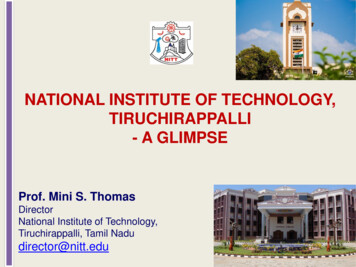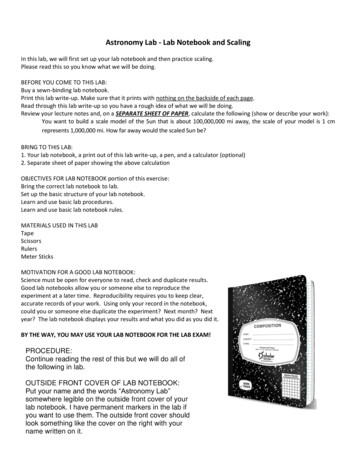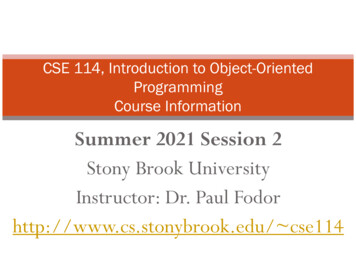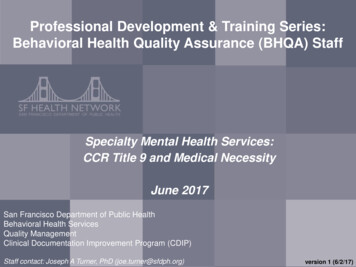
Transcription
Course Title:CoursePrefix:Computer Architecture LabCPETCourseNumber:Department of Engineering Technology3161SectionNumber:P01Roy G. Perry College of EngineeringInstructor Name:Office Location:Office Phone:Fax:Email Address:Dr. Yonghui WangS. R. Collins, Room 318936.261.9863936.261.9867yowang@pvamu.eduSnail Mail (U.S. PostalService) Address:Prairie View A&M UniversityP.O. Box 519Mail Stop 2530Prairie View, TX 77446Office Hours:MWF8:00am-9:00am, 12:30pm-2:00pmF12:30pm-5:00pmAnd by appointmentVirtual Office Hours:Contact by emailCourse Location:S. R. Collins, Room 205Class Meeting Days& Times:MCatalog Description:Prerequisites:(0-3) Credit 1 semester hour.Laboratory experiments to determine performance characteristics ofcommercially available microcomputers. Write codes for 8-bitthrough 32-bit processors to exercise the hardware.CPET 2111 and CPET 2113 with minimum grade of CCo-requisites:CPET 3163Required Text:Handouts will be available before each class.RecommendedText/Readings:Computer Organization and Design (5th edition) by David A.Patterson and John L. Hennessy, Morgan Kaufmann. ISBN: 978-012-407726-32:00 pm - 4:50 pm
CPET 3161-P01Spring 2016Required/Recommended Tools and Supplies:1. Scientific Calculator – available at campus Bookstore or anybusiness supply store. Examples include:a. Texas Instruments: TI-36X Pro (recommended)b. Casio fx-2602. Flash Drive3. Engineering Graph Paper (Green Pad)4. Electronics Components Part NavPath 2,842,1220&Prod TI-MYPARTSKIT&CFID 15577033&CFTOKEN DKit will be issued to student during the first week of class.Assignments and/or labs will be given based on components inthe kit.If the kit or any of its components are lost or stolen, it is thestudent’s responsibility to replace the kit or components. Nocomponents will be re-issued to the student by the department.Student Knowledgeand ExperienceAssumptions: Access to LearningResources:PVAMU LibraryTelephone: (936) 261-1500http://www.pvamu.edu/library/Use the Reference Desk at the library where the staff is eager toguide your research. They can orient you to hard copies and on-lineresources. Basic math skills required: complex numbers, basic trigonometricidentitiesUse of a scientific calculatorBasic proficiency with digital logic circuitsUniversity BookstoreTelephone: (936) emoKey dThe Writing CenterTelephone: (936) -center/The Writing Center’s goal is to provide a friendly, stress-freeenvironment for students from all over campus to meet with aconsultant and talk about writing of all types. They provide aresponsive audience and advice from experienced writers in sessions2
CPET 3161-P01Spring 2016generally lasting thirty to forty-five minutes. Sessions of this lengthoffer time to work individually with students on any aspect of thewriting process: from brain storming and drafting, to revising andproofreading. They will explore ways to improve a student’s overallwriting skills. They do NOT proofread or edit for students, butinstead teach proofreading and editing techniques. Their goal is to:make a better writer for the long term.The Tutoring CenterJohn B. Coleman Library - Room 209Telephone: (936) cas/Open to all undergraduate students enrolled for credit in targetedPVAMU courses.Student Academic Success CenterTelephone: (936) 261-1040https://www.pvamu.edu/compass/Student Academic Success Center identifies academic and socialroadblocks that interfere with persistence and timely graduation ofPVAMU students. SASC informs campus-wide policies by stayingcurrent with retention literature and best practices. Further, SASCdevelops programs and services that are specifically aimed atcontinuing the academic success of the first year. They strive toprovide PVAMU students with “Navigation to Graduation”Course Goals or OverviewStudents should be able to perform the following with a high degree of proficiency at the end ofthis course:1. Understand the MIPS architecture2. Understand the basic building block of any computer, such as multiplexer, demultiplexer,counters, adder/subtractorCourse Objectives/Accrediting Body - ABETStandards Met: SACS and ABETThis course contributes towards the following two objectives of the Computer EngineeringTechnology program:1. have successful careers in computer engineering technology and relatedmultidisciplinary fields to become successful leaders thereby fulfilling the specialpurpose mission of the university in serving the diverse ethnic and socioeconomicpopulation in the nation and world;2. have adequate foundation of self-guided learning for life to adapt to continuously3
CPET 3161-P01Spring 2016changing technologies through participating in professional training, workshop, andhaving membership in professional societies all directed towards achieving leadershippositions in lucrative professions;At the end of this course, the students will be able to perform the following:ABET Student Outcomes for thisAlignment with Course Specific Outcomescourse1 An ability conduct standard tests andStudents will demonstrate the ability to:measurements; to conduct, analyze and Conduct standard testsinterpret experiments; and to apply Analyze and interpret experimentsexperimental results to improveprocesses; (TAC/ABET outcome [c])2A commitment to quality, timeliness andcontinuous improvement; (TAC/ABEToutcome [k])Students will demonstrate the ability to: Demonstrate the commitment to quality,timeliness and continuous improvementCourse Requirements and Evaluation MethodsThis course will utilize the following instruments to determine student grades and proficiency ofthe learning outcomes for the course.Exams – written tests designed to measure knowledge of presented course materialLab Reports – written assignments designed to supplement and reinforce course materialClass Participation – daily attendance and participation in class discussionsGrading MatrixInstrumentLab ReportsMidterm ExamFinal ExamTotal:Semester weight, %602020100Grade Determination:A 90 – 100pts;B 80 – 89pts;C 70 – 79pts;D 60 – 69pts;F below 60.4
CPET 3161-P01Spring 2016Course ProceduresTextbook PolicyStudents must acquire the textbook that is listed as “required” on the course syllabus. Thetextbook must be acquired by the 10th class day. Students are not allowed to share textbookswith other students who are currently registered in the same class. Failure to acquire (or showproof of purchase) the required textbook by the 10th class day will result in the student beingadministratively dropped from the course. The University will assess financial obligations for thecourse to the student as with any other dropped class according to the fee schedule. In addition,your financial aid may be affected by the subsequent registration action(s).Go to or the Roy G. Perry College of Engineering Textbook PolicySubmission of AssignmentsAll assignments will be submitted on the eCourse web site for this course, unless otherwisespecified by the professor. Written assignments will be scanned to PDF form and submitted.The hardware for the Course Project will be presented and demonstrated on the final day of classfor credit as part of the course project grade.Note that scanners for Engineering Technology students will be available in SRC 203 and SRC302. Scanners are also available in the Coleman Library.Formatting DocumentsMicrosoft Word is the standard word processing tool used at PVAMU. If you’re using otherword processors, be sure to use the “save as” tool and save the document in either the MicrosoftWord, Rich-Text, or plain text format.Exam PolicyExams should be taken as scheduled. No makeup examinations will be allowed except underdocumented emergencies (See Student Handbook).Quizzes and Exams may include materialfrom any classroom activities. Additionally, the student is responsible for assigned readingsin the textbook, whether material is explicitly covered in class or not.Note that pop-quizzes may be given at any time during the class period to test theunderstanding of key concepts.For examination periods, students will place all backpacks, purses, and electronic devicesin the front of the classroom and will sit at locations designated by the instructor in theclassroom or lab for the duration of the exam. If the student needs to leave the exam forany reason during the examination period, the student must submit the exam to theinstructor and will not be allowed to do any more work on the exam.Missed or Late WorkIf a student is absent, all work due on the date of absence must be provided on eCourses per theassigned date for full credit. Late or incomplete work may receive partial credit, at the solediscretion of the instructor.5
CPET 3161-P01Spring 2016HousekeepingAll tools and lab supplies must be returned to their appropriate location.Please keep chairs and tables where they belong.Return all equipment, tools, etc. back where they belong.Please do not move, remove, swap, or replace any equipment. If you suspect any equipmentto be faulty, please bring it to your instructor’s attention.Classroom Conduct1. Interpersonal skills are critical to both working with peers and leading others. Students willconduct themselves in a manner that is respectful to their fellow classmates and the instructorat all times.2. In practice for the workplace, your preparation and complete attention to the subject matter iscrucial, as it would be in any place of employment. Therefore:2.1. Cell phones MUST be turned off during class time, no texting during class time.2.2. No earbuds allowed during class.2.3. Arrive to class on time and be prepared to discuss lesson.2.4. Always bring essential tools: Textbook, pencil, paper, scientific calculator (not cellphone).3. Business casual attire is encouraged, again preparing for the workplace.4. You are encouraged to work together on classroom exercises as collaboration and teamworkare important skills to learn. However, exams, quizzes, laboratory write-ups, andhomework assignments are strictly the individual’s responsibility and must be doneindependently. Recognized copying of work may result in a grade of zero for all partiesinvolved.5. Attend at least one day by the 10th class day or will be administratively dropped.Food and BeveragesOther than sealable bottles of water, food and beverage items are prohibited in the classroomand laboratory.Dress CodeEngineering Technology students are preparing for the professional world of work. Businesscasual attire is strongly encouraged to prepare students for company internships, co-operativeeducation work periods, or for visits by industry representatives to the classrooms or labs.However, certain minimum standards are required:1. Students are NOT allowed to wear caps/hats/hoods in class.2. Students must wear closed toe shoes in the laboratory. If you show up to lab in flip‐flops orany open‐toed footwear you will be asked to leave and you will be considered absent for thatlab.3. Students must remove jewelry from the hands when working with electrical equipment.Professional Organizations and Journals6
CPET 3161-P01Spring 2016IEEE (www.ieee.org)ReferencesSee eCourse web site for this course.Course CalendarWeek One:Topics: IntroductionReading:Week Two:Topics: MIPS assembly language IReading:Week Three:Topics: MIPS assembly language IIReading:Week Four:Topics: MIPS assembly language IIIReading:Week Five:Topics: Adders and subtractors IReading:Week Six:Topics: Adders and subtractors IIReading:Week Seven:Topics: Adders and subtractors IIIReading:Week Eight:Topics: Midterm TestReading:Week Nine:Topics: Spring BreakReading:Week Ten:Topics: IC counter IReading:7
CPET 3161-P01Spring 2016Week Eleven:Topics: IC counter IIReading:Week Twelve:Topics: IC counter IIIReading:Week Thirteen:Topics: Multiplexer/Data selector IReading:Week Fourteen:Topics: Multiplexer/Data selector IIReading:Week Fifteen:Topics: Demultiplexer/Data distributor IReading:Week Sixteen:Topics: Demultiplexer/Data distributor IIReading:Final ExamUniversity Rules and ProceduresDisability statement (See Student Handbook):Students with disabilities, including learning disabilities, who wish to requestaccommodations in class should register with the Services for Students with Disabilities(SSD) early in the semester so that appropriate arrangements may be made. Inaccordance with federal laws, a student requesting special accommodations must providedocumentation of their disability to the SSD coordinator.Academic misconduct (See Student Handbook):You are expected to practice academic honesty in every aspect of this course and all othercourses. Make sure you are familiar with your Student Handbook, especially the sectionon academic misconduct. Students who engage in academic misconduct are subject touniversity disciplinary procedures.Forms of academic dishonesty:1. Cheating: deception in which a student misrepresents that he/she has masteredinformation on an academic exercise that he/she has not mastered; giving orreceiving aid unauthorized by the instructor on assignments or examinations.Note that the first occurrence of a student caught cheating on an exam in this8
CPET 3161-P01Spring 2016course will receive zero points for that exam. If there is a second occurrenceof cheating on an exam by a student, the student will receive a failing gradefor the course.2. Academic misconduct: tampering with grades or taking part in obtaining ordistributing any part of a scheduled test.3. Fabrication: use of invented information or falsified research.4. Plagiarism: unacknowledged quotation and/or paraphrase of someone else’swords, ideas, or data as one’s own in work submitted for credit. Failure to identifyinformation or essays from the Internet and submitting them as one’s own workalso constitutes plagiarism.Nonacademic misconduct (See Student Handbook)The university respects the rights of instructors to teach and students to learn.Maintenance of these rights requires campus conditions that do not impede their exercise.Campus behavior that interferes with either (1) the instructor’s ability to conduct theclass, (2) the inability of other students to profit from the instructional program, or (3)campus behavior that interferes with the rights of others will not be tolerated. Anindividual engaging in such disruptive behavior may be subject to disciplinary action.Such incidents will be adjudicated by the Dean of Students under nonacademicprocedures.Sexual misconduct (See Student Handbook):Sexual harassment of students and employers at Prairie View A&M University isunacceptable and will not be tolerated. Any member of the university communityviolating this policy will be subject to disciplinary action.Attendance Policy:Prairie View A&M University requires regular class attendance. Attendance andpunctuality is expected and is vital to a thorough understanding of the course. Thestudent cannot develop the proficiency required for this course just studying the textbook.Lectures and/or labs may include material not covered in the textbook. If you cannotattend a particular class session, please discuss the conflict with the instructor inadvance (in person, via phone or email).Attendance will be taken at the beginning ofclass. Any student who is not present when attendance is taken may be counted as absentfor that class.Excessive absences will result in lowered grades. Excessive absenteeism, whetherexcused or unexcused, may result in a student’s course grade being reduced or inassignment of a grade of “F”. Absences are accumulated beginning with the first day ofclass.Student Academic Appeals ProcessAuthority and responsibility for assigning grades to students rests with the faculty.However, in those instances where students believe that miscommunication, errors, orunfairness of any kind may have adversely affected the instructor's assessment of theiracademic performance, the student has a right to appeal by the procedure listed in the9
CPET 3161-P01Spring 2016Undergraduate Catalog and by doing so within thirty days of receiving the grade orexperiencing any other problematic academic event that prompted the complaint.10
CPET 3161-P01Spring 2016Academic Calendar – Spring 2016January 19, Tuesday Late Registration and Drop/Add Begins Instruction BeginsJanuary 22, Friday Late Registration, Add Courses, Change Major/Certification or anyMatriculation Change Ends for Undergraduate Students – StudentWeb Registration Access ClosesJanuary 27, Wednesday General Student Assembly All Students to AttendFebruary 3, Wednesday 12th Class Day (Census Date) LAST DAY to Drop Course(s) without Academic Record Late Deadline to apply for Spring 2016 graduationFebruary 4, Thursday Withdrawal from courses with academic record ("W") BeginsFebruary 15, Monday 20th Class DayMarch 10-12, Thursday-Saturday Mid-Semester Examination PeriodMarch 14-19, Monday-Saturday Spring Break (University Closed)March 25, Friday Good Friday/Easter (Student Holiday)March 30, Wednesday Founders Day/Honors ConvocationApril 4, Monday Withdrawal from Course(s) with Academic record (“W”) EndsApril 12, Tuesday Priority Registration Begins for Fall 2016 SemesterApril 15, Friday Graduation Application Deadline for Summer 2016 AND Fall 2016May 2-3, Monday-Tuesday Course Review Day [Classes must convene and instructors willprepare students for Final Exams]May 3, Tuesday Last Class Day for Spring 2016 Semester Last Day to Withdraw from the University (From All Courses)May 4 - May 10, Wednesday-Tuesday Final Examination Period11
1. Understand the MIPS architecture 2. Understand the basic building block of any computer, such as multiplexer, demultiplexer, counters, adder/subtractor Course Objectives/Accrediting Body - ABET Standards Met: SACS and ABET This course contributes towards the following two objectives of the Computer Engineering Technology program:










